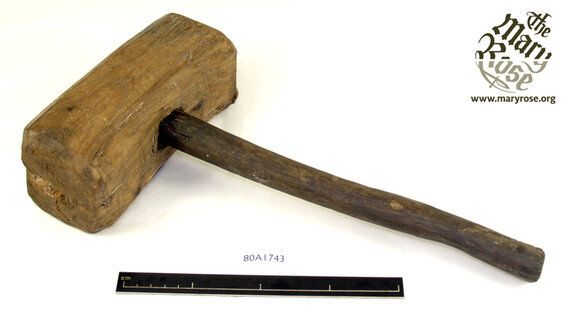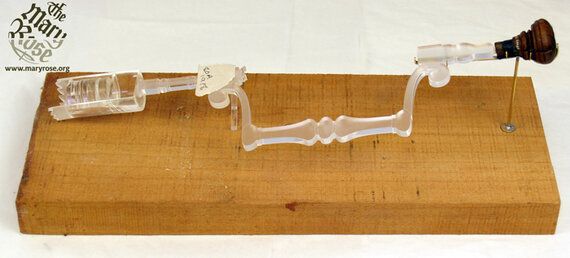Being a warship, the Mary Rose carried a lot of objects that were, shall we say, unpleasant.
As well as the various ship-to-ship weapons, there were pikes, daggers and swords, longbows and handguns for long distance attacks, and rather nasty antipersonnel weapons such as the hailshot piece, a short barrelled gun that was used to blast iron dice at enemy boarders at close range.
It wasn't just the weapons of war that were nasty; some of the devices used to make people better were just as gruesome. Medicine wasn't as brutal as it had been; the surgeons on ships were trained professionals who had studied and served apprenticeships. Some of the techniques they used aren't much different from those performed on the battlefield today, but you still wouldn't want to become seriously ill in Tudor England.
Which leads us nicely into our first object...
The Mallet

In the museum, whenever you visit the surgeon's handling table, you are guaranteed see someone point at the mallet and say knowingly to their partner "That's the anaesthetic!" However, even Tudor surgeons knew that a blow to the head is a terribly dangerous way to render someone unconscious; it damages the brain, and risks fracturing the skull. If you're VERY lucky, and you recover within a couple of minutes, you'll wake with a massive headache and the extra pain of an operation in progress (plus probably a few other complications, which we'll get to later). Any longer, and you might not wake up at all.
Tudor amputations took place with the patient conscious. The original injury would either have put them into shock, numbing the senses, or make whatever the surgeon was doing seem relatively painless (and if they could afford it, they'd be given a soporific sponge, soaked in opiates that would reduce the pain). Either way, there would be plenty of people to hold them down while the surgeon got on with the job.
So, what was the mallet doing in the surgeon's cabin, if not for bonking people on the head? With surgery, the name of the game was speed. The faster the operation was done, the quicker they could be patched up and the more likely they were to recover. With amputations, a flesh knife, razor sharp and curved, will slice through the flesh quickly, while a saw takes care of the bone. This is fine for an arm or leg, but for a finger or toe, it's far quicker to use a mallet and chisel, which would take off the damaged digit, quickly and (relatively) painlessly.
Chafing dish

Closing wounds is very important. Firstly, it stops the patient bleeding to death but it also prevents the wound from becoming infected; but this only works if you know what causes infection in the first place. Tudor medicine had yet to adopt germ theory, mainly because nobody knew what germs were. However, they understood the importance of cleanliness; surgeons tools were required to be kept clean (although not to today's standards), while open wounds would be washed out with wine or vinegar.
One of the more hygienic ways of closing a wound was to suture it; stitching the flesh together over the wound. Sadly for English sailors, while the French were doing this, the English surgeons were still employing the technique of cauterisation; using 'irons' heated in a chafing dish to essentially 'cook' the wound closed. Anyone who's burnt themselves will know that burns can go septic pretty quickly and even more so in a cramped environment like the Mary Rose.
Trepan

Let's imagine that some idiot has hit you on the head with a mallet, because he ignored what I wrote further up the page. You've not been killed, your skull appears to be intact and, despite feeling fine for a while, you're now dizzy and have a massive headache. While there are several possible causes for this, in this hypothetical case you've developed an epidural haematoma where blood is filling your skull putting pressure on the brain.
If this happened on the Mary Rose, the surgeon would attempt to relieve the pressure by slicing through the scalp, exposing the skull, and using a trepanning drill to cut though the bone until it had cut a circular hole in the bone allowing the excess fluid to be drained off. To close up the wound, a silver coin would be placed over the hole (silver is an excellent antiseptic!), and the scalp would be stitched up and covered. The patient would then be left to recover.
Urethral syringe

Sailors, it's unfortunate to say, had a bit of a bad reputation when it came to shore leave. When they went ashore after periods at sea, some sought female company, often for a small fee and many returned to the ship with more than they bargained for.
Treatment for venereal diseases was not pleasant. Urethral syringes would be filled with liquids such as mercury then inserted up the urethra so these caustic fluids would burn off any sores. This would be uncomfortable, painful, and require repetitive treatments. This was also one of the few treatments not administered free of charge by the surgeon; as it wasn't considered a work-related injury!
I feel obliged to point out that, although traces of mercury were found in the chest of the ship's surgeon, the bones of the crew of the Mary Rose show no traces of syphilis. Clearly our particular sailors were very well behaved!
Enema Pipe

Imagine it's 1980, and a chest has been recovered from a cabin on the Mary Rose. Inside this chest, as well as the usual pots of ointments and surgical tools, is what appears to be a whistle, with a flanged end that had a fragment of leather on it. You perform various tests on it. You blow, trying to get it to play a note, but it can only produce a note if you put it very carefully on the tip on your lips.
Frustrated, you examine the literature and discover that the leather was the remains of a fluid bladder, and what you've had in your mouth was an enema pipe, which had probably been used to administer medicines rectally to several people over the course of its active life. A true story, and perhaps something one of our staff members would rather forget!
